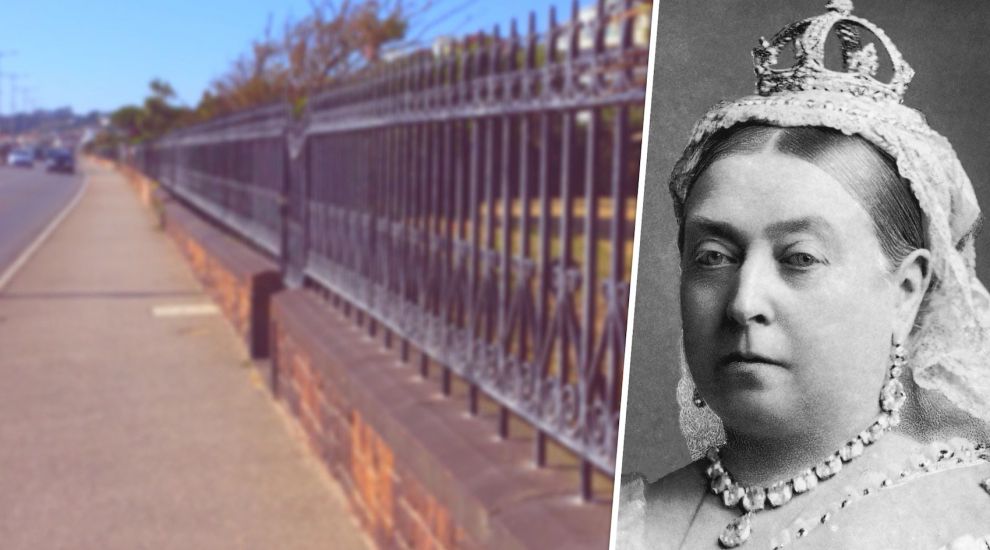


An email sent in error by Planning has resulted in a section of historic railings installed along Victoria Avenue to commemorate Queen Victoria's Diamond Jubilee being replaced to the wrong specification.
The distinctive black railings, which line the road between the Lower Park and First Tower, were erected at the end of the 19th century.
They were put up at the same time as Victoria Avenue was built, which opened in 1897, the year of the anniversary.
Paid for by the Government, the granite wall and ornamental railings were given to the property owners, in part as compensation for their loss of land through which the road was built.
However, with the transfer came responsibilities: property owners signed a covenant, in force to this day, which obliged them to maintain them to a reasonable standard.
The Government held the legal responsibility to ensure that the terms of the covenant were upheld, and later issued guidance that the railings, if replaced, had to follow the original design.
Pictured: Mr Rylance has highlighted the railings in question on Facebook.
However, the recent replacement of a section of railings at First Tower has fallen short of the required standard - but Planning is not enforcing the terms of the covenant or their rules because an officer has already signed off the work.
The apparent mistake has been highlighted by heritage campaigners, as well as blacksmith Stephen Rylance, whose quote for the like-for-like replacement of the old railings was rejected by the developer.
Mr Rylance said: “The 550m of wrought iron railings and dressed granite walls along Victoria Avenue are listed grade four,” he said.
“That means when someone wants to restore them, they must save as much of the original ironwork as possible and replicate the missing sections.
“Or, if the railings are beyond saving, new ones must be made to the same design as the originals.
“The only concession Planning allows is that mild steel can be used instead of wrought iron.
He continued: “As we specialise in the restoration and reproduction of historical ironwork and have restored four sections of railings along Victoria Avenue to date, we were asked to price to supply and fit new sections to replace some clearly unsavable originals.
“I submitted my price in early 2018, and the developer responded that he could get the railings from a UK supplier at one quarter of the cost. I suggested he couldn’t if the makers were adhering to the rules. We didn’t get the business.
“I went to see the first sections of the new railings when they were fitted on site last December.
“The new railings have been well fabricated, clearly look the part and function perfectly.
“Unfortunately, everything is welded together with no attempt to disguise the welding. The square uprights have not been passed through square holes in the top and bottom rails but have been welded in between on top and underneath.”
Mr Rylance added that each section was the wrong size and the joints were incorrect.
“Clearly these railings are not the mandated design,” he said. “I sent my observations to the Historic Environment team at Planning, who agreed with me and sent the file to their compliance department.
“Unfortunately, it seems that someone at Planning had already emailed the developer stating that all conditions had been discharged before the Historic team were asked to comment.
“Despite Planning realising their mistake, they decided it couldn’t go backwards and that we must put this down to experience and make sure this doesn’t happen again.”
Pictured: The 550m row of railings were erected as part of Queen Victoria's Diamond Jubilee celebrations in 1897.
“When I suggested that Planning should enforce their own conditions, I was told it was not in the public interest to take it further," he continued.
“What is the point of trying to protect these important examples of the Island’s unique history if Planning fails to act?”
Mr Rylance said he had “jumped through hoops” during previous repairs to make sure his work honoured the covenant and he was saddened to see sub-standard recreations being allowed to be installed.
Historic buildings consultant Antony Gibb, who helped the Government draw up guidelines on the maintenance of the railings in 1997, said that Planning’s response had not been good enough.
“Planning has the legal responsibility to ensure that the covenant is being complied with. In this case, it appears that someone signed off the railings and the department are now holding up their hands and saying, ‘We’re sorry about that.'
“But that is not good enough because when you open the stable door, the inevitable will happen. This is the second time that I am aware that sub-standard railings have been allowed to be installed, and the heart of the question is, ‘How much do we actually care about our historical buildings and monuments?’
“Developers will always try to keep costs down but it is far easier if the Government plays a straight bat at the very beginning, and insist that their own guidelines are followed.”
It is understood that the ownership of the property has changed over the course of the development.
In a statement, the Government said: “Having investigated the matter fully, the department concluded that it was unable to enforce the installation of the correct specification of railings for this site.”
Comments
Comments on this story express the views of the commentator only, not Bailiwick Publishing. We are unable to guarantee the accuracy of any of those comments.